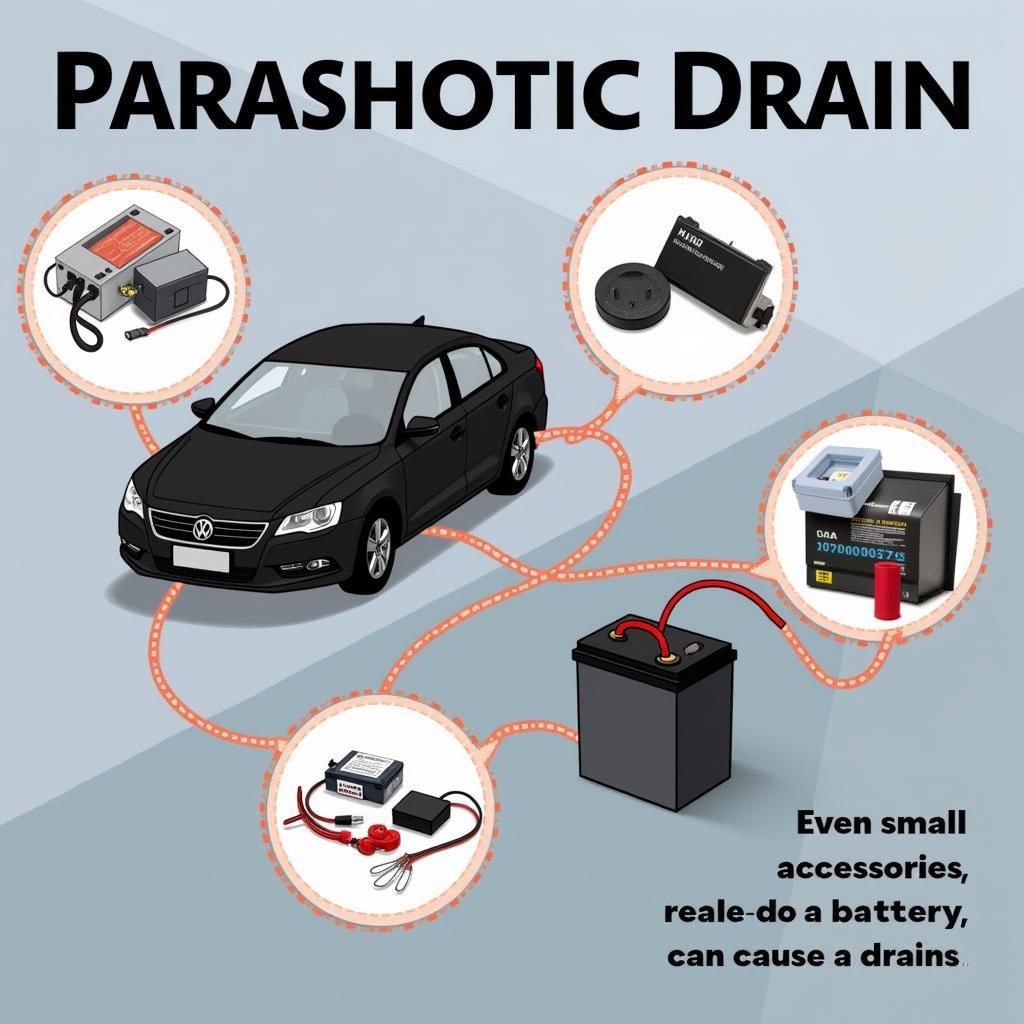A parasitic drain on your car battery is a silent killer, slowly draining power even when the engine is off. This can leave you stranded with a dead battery, especially after a few days of inactivity. Understanding how to diagnose and fix a parasitic battery drain is essential for any car owner. Let’s dive into the common causes and solutions.
A parasitic battery drain can be caused by anything from a faulty alternator to a glove box light that stays on. Locating the culprit can be tricky, but with the right tools and knowledge, you can conquer this automotive gremlin and keep your car starting reliably. bluetooth adapter for old car radio can sometimes contribute to a drain, so ensure it’s installed and functioning correctly.
Understanding Parasitic Battery Drain
What is a parasitic drain and how does it affect my car battery?
A parasitic drain, also known as a phantom drain, is any electrical component that continues to consume power after the car is turned off and the key is removed. This slow but constant drain can deplete your battery over time, leaving you with a dead battery, especially in colder climates or if your battery is already weak. A common misconception is that only major components cause these drains, but even small things like interior lights, faulty relays, or aftermarket accessories can be the culprit.
 Parasitic Drain Illustration
Parasitic Drain Illustration
Diagnosing the Parasitic Drain
How can I test for a parasitic drain on my car battery?
Testing for a parasitic drain requires a multimeter, which measures electrical current. Here’s a step-by-step guide:
- Safety First: Disconnect the negative battery cable.
- Connect the Multimeter: Set your multimeter to the DC amps setting. Connect the red lead to the negative battery terminal and the black lead to the negative battery cable.
- Observe the Reading: A reading above 50 milliamps (0.05 amps) generally indicates a parasitic drain.
- Isolate the Circuit: Begin removing fuses one at a time while observing the multimeter. When the reading drops significantly, you’ve identified the circuit containing the drain.
If you’re uncomfortable working with electrical components, it’s always best to consult a qualified automotive technician. They have the tools and expertise to pinpoint the problem quickly.
“A simple test with a multimeter can save you the headache of a dead battery,” advises John Smith, Senior Automotive Technician at Smith Automotive Solutions. “Regularly checking for parasitic drains can also extend the lifespan of your battery.”
Common Culprits of Parasitic Drain
What are the most common causes of a parasitic drain?
- Interior Lights: A faulty door switch can prevent interior lights from turning off completely.
- Faulty Alternator: While not technically a drain, a bad alternator can prevent the battery from charging properly.
- Glove Box or Trunk Light: These lights can stay on if the switch is malfunctioning.
- Aftermarket Accessories: Improperly installed car stereos, alarms, or other add-ons can be significant power consumers.
- Stuck Relays: A relay stuck in the “on” position can continuously draw power.
Sometimes, a simple bluetooth car radio adapter iphone can cause unexpected drain if not properly configured. Ensure all your devices are compatible and set up correctly to avoid any potential issues.
Fixing the Parasitic Drain
How can I fix a parasitic drain issue in my car?
Once you’ve identified the circuit causing the drain, you can further pinpoint the specific component. This might involve inspecting wiring, testing individual components, or consulting the car’s wiring diagram. Replacing faulty switches, relays, or components is usually the solution. If you’re not comfortable performing these repairs, consult a professional.
 Mechanic Testing Car Battery
Mechanic Testing Car Battery
A bluetooth car radio adapter android or an iclever wireless bluetooth fm transmitter radio adapter handsfree car kit can be a great addition to your car, but ensure they’re installed correctly to avoid becoming part of a parasitic drain. An isunnao fm transmitter bluetooth wireless radio adapter car kit offers similar functionality and can be a good alternative.
Conclusion
Addressing a parasitic drain on your car battery is crucial for avoiding the frustration of a dead battery and potential damage to electrical components. By understanding how to diagnose and fix these drains, you can keep your car running smoothly and extend the life of your battery. Regularly checking for parasitic drain is a proactive measure every car owner should consider. Remember, a simple multimeter and some basic knowledge can go a long way in preventing unexpected breakdowns and costly repairs.
FAQ
- What is a normal parasitic drain reading? A reading below 50 milliamps is generally considered normal.
- Can a car battery drain overnight? Yes, a significant parasitic drain can deplete a battery overnight.
- How long does it take to diagnose a parasitic drain? The diagnostic process can take anywhere from a few minutes to a few hours, depending on the complexity of the issue.
- Is it safe to drive with a parasitic drain? Driving with a parasitic drain can lead to a dead battery and leave you stranded. It’s best to address the issue promptly.
- How often should I check for parasitic drain? It’s a good idea to check for parasitic drain every few months or if you notice any signs of battery weakness.
- Can extreme temperatures affect parasitic drain? Extreme temperatures can exacerbate the effects of a parasitic drain, making it more noticeable.
- Will disconnecting the battery overnight fix a parasitic drain? Disconnecting the battery will prevent further drain but won’t fix the underlying issue. You’ll need to identify and repair the cause of the drain.
